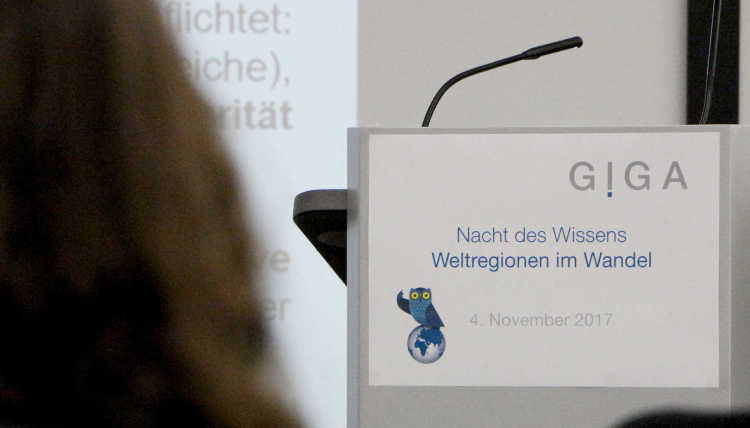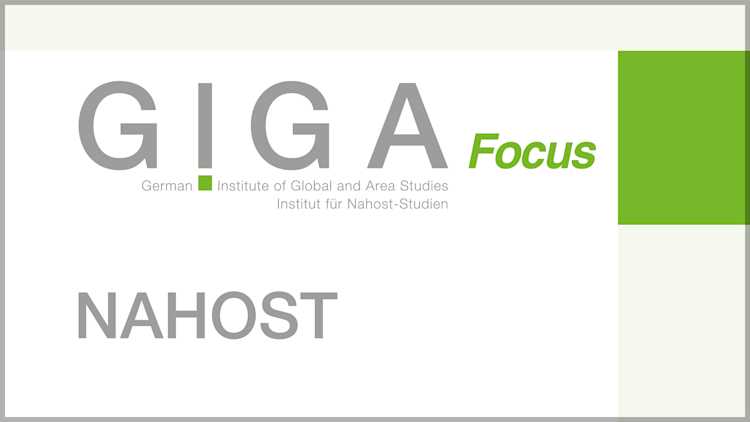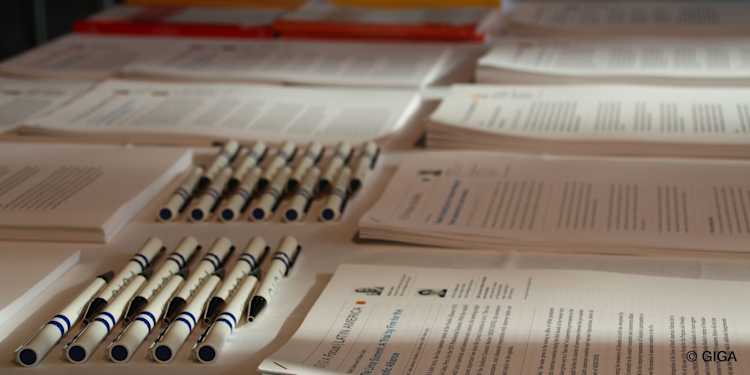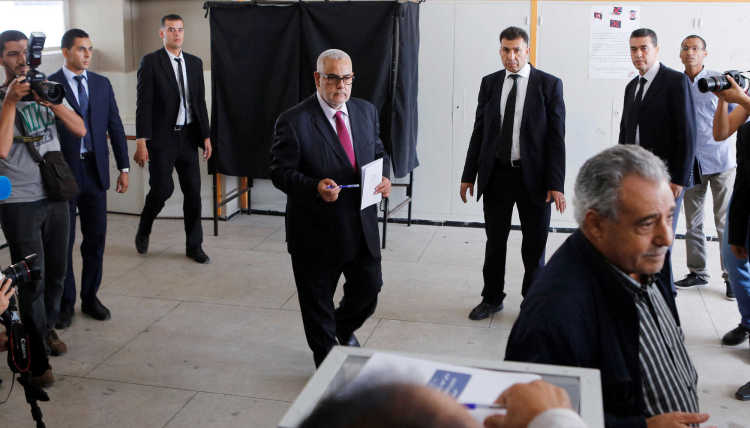- Home
- Publications
- GIGA Focus
- The Arab Spring: Misconceptions and Prospects
GIGA Focus Middle East
The Arab Spring: Misconceptions and Prospects
Number 4 | 2016 | ISSN: 1862-3611
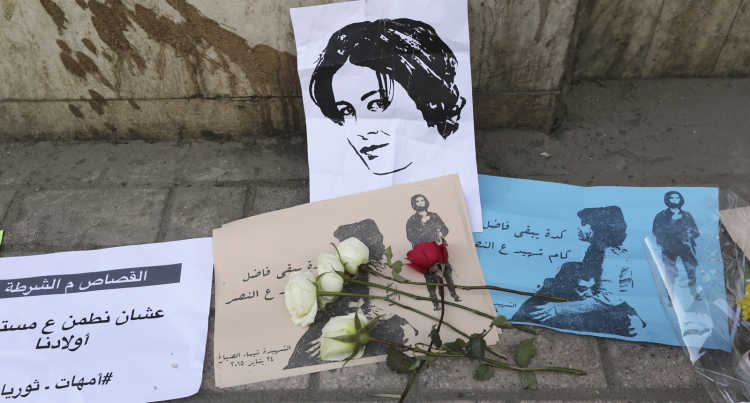
The Arab Spring of 2011 is acknowledged as a turning point for the Arab world. While there were high expectations at the outset regarding the democratisation of the region, at present pessimistic assessments predominate, given the numerous wars and the return of authoritarian rule. At least four misconceptions about the Arab Spring can be identified, and these provide information important for a more realistic appraisal both of the likelihood of future democratic reforms and of the challenges to lasting stability in the region.
Many Western observers were surprised by the Arab Spring, despite numerous indications of deep dissatisfaction among the people of the region, and even though most of the deficiencies of authoritarian rule and of economic underdevelopment had been recognised for decades.
The expectation that the Middle East would democratise based on a Western model ignored the fact that democratisation was not a priority for most protestors, partly because of the Janus-faced use of the term “democracy” by Western actors in the region.
Despite some shared characteristics among the region’s countries, the Arab Spring was not a homogeneous movement. Aside from similar structural problems and some general demands on the part of demonstrators for dignity and justice, the protests took a different form in each country.
As a result of the electoral success of moderate Islamists and the rise of violent jihadist actors, some observers postulated an “Islamic Winter” sweeping the region. But this perspective has proven to be somewhat flawed, as the increasing level of confrontation between Sunnis and Shiites and between the Muslim Brotherhood and the Salafists, as well as the proclamation of the ISIS caliphate, have plunged political Islam as a whole into an identity crisis.
Policy Implications
Contrary to the initial hopes for a fundamental reform or even a revolution vis-à-vis existing conditions, the Arab Spring has left in its wake a region that evinces deep cleavages and that is characterised by violent conflicts. Nevertheless, Western countries must not revert to their pre-2011 political approach, alleging that the pursuit of regional stability justifies supporting the reinvigorated authoritarian regimes.
The Arab Spring as a Turning Point
In early 2011, mass demonstrations that would go down in history as the “Arab Spring” shook the Middle East. Except in the small Gulf monarchies of Qatar and the United Arab Emirates, there were demonstrations against the ruling regimes in every Arab country. In some countries, they developed into broad protest movements crossing ethnic and religious boundaries. Long-standing despots were overthrown in Tunisia, Egypt, Libya, and Yemen (Rosiny 2011; Richter 2011). Rightly so, these occurrences are spoken of as a major historical event (Perthes 2011), a turning point for the Middle East.
However, almost none of the initially high expectations held by most of the people in the region were met. Neither were fundamental reforms implemented nor were – except in the case of Tunisia – constitutionally guaranteed and state-protected civil rights and liberties introduced. Through a mixture of a carrot-and-stick approach, cosmetic reforms, financial incentives, a ramped-up use of both surveillance technology and methods of state repression, and even violent suppression of the opposition, most autocrats succeeded in co-opting, dividing, intimidating and, finally, subduing the heterogeneous protest movements. Following a short period of instability, many authoritarian regimes were able to consolidate their rule. After the world market price for crude oil first began to drop in 2014, the economic and social situation in most of the region’s countries became even more critical. The root causes of the waves of protest in 2011 – authoritarian regimes and long-standing socio-economic crises – persist unabated.
Only in Tunisia, whose President Ben Ali fled the country on 14 January 2011, was a regime change initiated which led to a process of democratisation that has managed to endure – though it should in no way be seen as irreversible. In Syria, Libya, Yemen, and Iraq, mutually reinforcing violence in protests that began peacefully escalated between demonstrators and forces of state repression. These conflicts led to civil wars that are ongoing and whose flames are being fanned by intervening, rivalling regional powers. The consequences of the dramatic regional upheavals extend to Europe: in the power vacuum of failed states, jihadists from Al-Qaeda and the self-proclaimed “Islamic State” (IS) have established themselves, carrying out terrorist attacks worldwide. Millions of people are fleeing war and violence. So far, only a small portion of them have made it to Europe, but it was enough to throw the European Union into a serious crisis. How is it that the Arab Spring, which once had been such a beacon of hope, ended up escalating into civil wars in some countries and leading to the restoration of autocrats in others? Do the prerequisites for a fundamental reform of political systems not (yet) exist in the Arab world? Was the expectation of widespread democratisation expressed by exogenous forces and by certain actors in the region unrealistic from the get-go?
In a critical review of the events of 2011, four misconceptions related to the Arab Spring can be identified.
The Onset of the Arab Spring: Out of the Blue?
Many researchers and politicians were caught off guard by the Arab Spring’s onset and by the speed with which it spread throughout the region. In the course of 2011, various publications asserted that the Arab Spring “came out of the blue.” Even today it is still claimed that the developments of early 2011 could not have been predicted (see, for example, Howard and Walters 2014). If, however, the situation before 2011 had been more carefully examined, one would have noted indications that increasing protests were taking shape. There had been demonstrations since the 1990s in most of the countries of the region – around corruption, despotism, social injustices, and economic inequality. Workers struck for higher wages and in protest of massive job loss. Most of these protests remained relatively localised, limited to the national realm, going unremarked upon at the regional and global levels. This began to change only at the turn of the millennium, as protests proliferated in several countries. The Second Intifada in the Palestinian territories in 2000, the US-led Iraq War to topple Saddam Hussein in 2003, and the publication of the Muhammad caricatures in 2005 drew people to the streets from Morocco to Yemen. These demonstrations of discontentment, however, were only obliquely directed at the respective country’s authoritarian regime. Often, inactivity on foreign policy was the sole complaint directed towards the regime. But in some cases, even then, there were instances of protest explicitly targeting the ruling autocrats; most of those protests were repressively quashed.
Moreover, many of the deficits named by the Arab Spring demonstrators had been recognised for years. In the first decade of the 2000s, a group of Arab scholars drafted the Arab Human Development Reports, an impressive documentation of the political, economic, and social problems of the region. Economic underdevelopment and enormous wealth gaps within and between countries were accompanied by a high rate of youth unemployment in most of those countries. Globalised media and a sharp increase – on paper – in the level of educational attainment raised people’s expectations. But because of inadequate education, a lack of jobs, and abusive treatment by the state, these expectations largely went unmet, particularly in the republican regimes. The classified American embassy cables published by Wikileaks shortly before the Arab Spring corroborated the corruption of the Arab regimes and laid out in black and white what most people in the region had already suspected. In the particular case of Tunisia, the publication of evidence of the extent of corruption within President Ben Ali’s family played a key role in the outbreak of the protests there.
Therefore, it was not a question of whether but when the collective disaffection would finally boil over. Nevertheless, not a single one of these deficits has yet been redressed. In fact, many of the problems have even intensified and come to a head since the initial drop in the crude oil price in 2014. The political elites still see no need to introduce reforms and are instead once again focusing on stabilising their political power.
The Arab Spring: A Democratic Movement?
At the beginning, many observers viewed the protest movements of the Arab Spring in the context of latecomers to the “third wave of democratisation,” to use Samuel Huntington’s terminology. Some argued that the events that have taken place in the Arab world since 2011 belong to a “fourth wave of democratisation” (Joffe 2011), while others spoke of even a “fifth wave" (Engin 2011) whose origin is the Middle East. Area experts, however, were more cautious in their judgments; though, even some of them considered the establishment of democratic conditions to be the main objective of the developments in the region (Gerges 2013).
It quickly became clear that these descriptions were too optimistic; at best, they were premature. Even in Tunisia, the model country of the Arab Spring, the democratisation following a Western example that many had hoped for remains a deficient and crisis-prone process. In Egypt, the prospects for democracy were crushed by an army coup in 2013; democracy hardly had a chance in any of the other countries. As a result, one could speak of a total failure of democracy in the Arab world.
In our view, it was flawed, exogenous wishful thinking right from the beginning that underlay the idea of a “wave of democratisation.” The Arab Spring produced only very few demonstrators who demanded the introduction of democracy. The protestors’ demands focused much more on issues of justice, freedom, and dignity, and they spoke against despotism, corruption, and clientelism. In some countries there were voices calling for the “overthrow of the system,” but not in a single country was there significant demand for the installation of a liberal democracy. This does not mean, however, that the people of the region were not interested in democracy or that Muslims are inherently incapable of living under a democratic system. The reasons that the introduction of liberal democracy was not at the core of the Arab Spring are multifaceted and can be explained within a historical context.
Protestors came from nearly every single stratum of society. They publicly deplored a reality that no longer corresponded in any way to the visions and promises that the leaders of the republican regimes themselves had championed since independence (Schumann 2015). Nevertheless, in the course of 2011, secularists, Islamists, and the diverse, fragmented former opposition forces in each of those camps were unable to formulate a shared alternative vision of political order. The most significant actors from among the opposition groups viewed the future division of state power as, first and foremost, a zero-sum game. Except in the case of Tunisia, opposition forces were not capable of creating a new form of political power balancing that could have set in motion a process of democratisation. This failure of new (and old) political elites to find a political compromise can be explained essentially by three factors:
First, over the past several decades, the authoritarian regimes have suppressed the secular opposition and parts of the Islamic opposition, relying on the argument that divergent political thought would threaten national unity and security. As a consequence of this, a culture of critical political debate could not be established. Second, the authoritarian rulers have convinced the West that, given the threat posed by political Islam, their form of “guided democracy” is the preferable alternative. After the attacks of 11 September 2001 and in the joint “War on Terror,” the West silently accepted the repression of protests, resumed its arms delivery, and supported, in the form of generous financial assistance, the purported reforms. From the West’s perspective, the primacy of political stability was clear, even if that rule was authoritarian (Schlumberger 2012). Third, the people of the region were suspicious of liberal democracy, viewing it as a concept that the West, in the pursuit of its own interests, selectively either instituted or – when democracy ran counter to the West’s interests – suspended. The United States used the idea of the introduction of democracy to legitimise its invasion of Iraq in 2003, flouting international law. But the West had also supported, or at least tolerated, military coups following elections won by Islamists in Algeria in 1992 and against Egypt’s elected president, a member of the Muslim Brotherhood, in 2013, in addition to having boycotted the Hamas-led government elected in the Gaza Strip and the West Bank in 2006. Many opposition actors therefore doubted the sincerity of the West’s intentions when the latter demanded the introduction of “real” democracy in the Middle East.
The Arab Spring: A Homogeneous Movement?
A third misconception is that the Arab Spring was a cohesive protest movement across the entire region. There were large areas of overlap in the causes of the discontentment, the forms of mobilisation, and the overarching demands for justice (adala), freedom (hurriya), dignity (karama), and respect (ihtiram). Those similarities notwithstanding, there were big differences from country to country that prevent us speaking of a homogeneous movement. The composition of the protest movements, the initiation and eventual direction of the demonstrations, the concrete demands of the opposition, and the reactions to those demands on the part of the authoritarian regimes – a mixture of repression and modest accommodation – were sometimes strikingly divergent. These differences correlate to wealth gaps across the region and within individual states: a particularly drastic contrast is represented by the Gulf monarchies on one side and Yemen, Egypt, and Syria on the other. In addition, social stratification, education levels, and the degree of industrialisation and urbanisation in each country shaped the make-up of the protestors and their concrete demands in addition to the resources available to both the opposition and the authoritarian regimes.
Because of these differences, the dynamics of the protests also differed, as did each regime’s reaction. We can describe three basic constellations, which went on to develop in country-specific ways:
In some countries, including Egypt, Lebanon, Morocco, and Oman, youth from among the educated middle classes of the urban centres called for protest via their social networks. Modern media allowed many more people to be reached and drove the transnationalisation of the protests, which is why the number of demonstrators was unexpectedly high when viewed against earlier, similar events. Furthermore, the youth in some countries succeeded in politically activating segments of the lower and middle classes. State repression did not end the protests; rather, it led to their further mobilisation and expansion.
In Tunisia, Jordan, Bahrain, Syria, and Saudi Arabia, the protests started out on the periphery and were carried by groups that were discriminated against throughout the region or along socio-economic, sectarian, or ethnic lines. Only subsequently did countrywide movements emerge, movements that in some but not all cases succeeded in bringing the protests to their respective country’s centre of power. In some countries – for example, Saudi Arabia – the protests were completely limited to a few groups and a few areas outside of the capital. Protests raged on and intensified only in places where the urban and peripheral orientations could be united to form a wide national movement; this was the case in Tunisia, Morocco, Syria, Libya, and Egypt.
The countries also differ in their experiences with past protests and uprisings, which served to shape the character of the exchanges between the regime and the opposition during and after the Arab Spring in ways that were specific to each country. In states with histories of civil war, such as Lebanon, Sudan, and Algeria, as well as in Palestine and Iraq, protests either did not take place at all or were relatively moderate. It was not an infrequent worry that further sociopolitical polarisation could lead to renewed violence.
In addition, the ways that militaries and security forces in each country reacted to the protests differed. Tunisian forces refused to follow orders to shoot at demonstrators, while in Egypt the police initially carried out such an order. Later, Egyptian military leaders arranged for the immobilisation of the police and the resignation of President Mubarak, not least in order to secure their own positions of power in the state and in society in general. The Egyptian army is in possession of major commercial enterprises, so its leadership has a direct interest in hindering attempts at drastic economic reforms and certainly in preventing a radical shift in the balance of power. The Tunisian army, by contrast, aligned itself with the demonstrators against the regime. The Syrian army experienced several desertions but no split, and the segment of the security apparatus that is loyal to Assad is still fighting the uprising with exceptional brutality.
Arab Spring, “Islamic Winter”?
When the Muslim Brotherhood won majorities in the first free parliamentary elections in Egypt and Tunisia, respectively in 2011 and 2012, many Western observers were not just surprised but also disappointed that liberal forces in the opposition had received such little support from their own people. It was feared that the whole region would be vulnerable to Islamisation and concomitant radicalisation – additionally because the local branches of Al-Qaeda in Iraq and Syria, which would emerge as the “Islamic State” in 2014, were gaining traction. For area experts, however, the success of moderate Islamists did not come as much of a surprise; they recognised that many of the Islamists had been critical of the region’s authoritarian rulers for decades and therefore enjoyed high credibility among broad swathes of the population. In addition, Islamist actors were committed socially and economically on the local level in that they provided welfare services, schools, and educational opportunities and ran their own commercial enterprises, creating thousands of jobs.
Nonetheless, disappointment regarding the elected Islamist governments’ failure to adequately deliver concrete government services and fulfil economic promises contributed to their overthrow – in Egypt, in the form of mass protests and a military coup in July 2013, and in Tunisia as its people handed Ennahda an electoral loss in October 2014. As a result of that, fundamentalist Salafists in those two countries demanded an intensification of religious principles, but did not offer any real solutions to basic social and economic problems. Moreover, the civil wars that had flared up in Syria, Libya, and Yemen created arenas of violence that facilitated the spread of jihadists prepared to use violence. This development culminated in the proclamation of a caliphate in Syria and Iraq by IS in June 2014.
The overthrow of the Muslim Brotherhood in Egypt, the increasingly sectarian nature of regional power conflicts between “Sunni” Gulf monarchies and “Shiite” Iran, and the aforementioned proclamation of the cult-like, apocalyptic caliphate led to an enormous crisis in the religious self-projection of Sunni Islam. Whether moderate Islamists will end up radicalising in a climate of state repression and civil war, or whether they will be able to develop a more tolerant and pluralistic model to counter the radical one embodied by Al-Qaeda and IS, represents one of the most salient unknowns for the future of the region (Rosiny 2016).
Realistic Prospects for the Arab World
The Arab Spring was not spurred by coincidental or spontaneous protest movements. Much more responsible were the pervasive structural conflicts that have been plaguing the relationship between the rulers and the ruled in Arab states for decades. Corrupt authoritarian regimes that had acceded to power in the 1950s and 1960s as leaders of nationalistic republics with noble visions of political and economic progress proved themselves at the beginning of the twenty-first century to be institutionally and economically underdeveloped states and deeply divided societies evincing massive wealth gaps. Crossing social, ethnic, and religious boundaries, the Arab Spring was an expression of despair that reached critical mass at the beginning of 2011 despite both huge restrictions on freedoms and overt repression. Democratisation was on the minds of only very few; the movements were primarily about resolving grievances and achieving dignity, freedom, and justice. Tragically, not one of the demands in these areas has been met. In fact, the gap between the rich and the poor has widened, and the chances are fading that a comprehensive reform of the relevant political systems will take place. Worse still, a power struggle over regional leadership positions is causing local conflicts to escalate into bloody proxy wars. The drop in global energy market prices that began in 2014 aggravated these problems, as the regimes had to restrict their spending on material benefits.
With reference to the bleak situation in Syria, Libya, Iraq, and Yemen, Sunni regimes such as Sisi’s Egypt and oil-rich Saudi Arabia caution that the alternative to their “stable” rule is neither political freedom nor democracy, but civil war and Islamist terrorism. The political elites are polarising their own people at the expense of certain ethnic and religious communities, presenting themselves as the “protectors of the people,” and warning of foreign conspiracies and the threat posed by Shia Iran in order to justify the persecution of problematic critics and oppositional groups (Gengler 2016).
Neither Perthes (2015) nor Lynch (2016) foresees a decline in violence. European and other Western countries must prepare themselves for further fragmentation, including widespread violent conflicts and enduring confrontations between civic protest groups and repressive regimes. This pessimistic perspective is more realistic than the fantasy of guided democratisation that was popular among European governments prior to the Arab Spring. What consequences will all of this have for scholarly engagement with the region, and what challenges will arise for German and European foreign and development policy?
Speaking from an academic perspective, we must not fall into old patterns of interpretation and assert that either a culturally contingent rejection of democracy or the lack of state institutions was responsible for the crisis in the region. An exclusive focus on the allegedly stabilising role of authoritarian regimes is also of no help here. In our view, there are three uncharted areas to which future research should look for a new perspective:
What current and future goals and strategies are being developed by moderate Islamist actors? Too little is known about how they will position themselves respective to the reconsolidated autocracies, the rise of Iran, the entrée of Russia into the concert of regional powers, the acts of violence carried out by Islamist terrorists, or with regard to the most urgent problems in the realms of social and economic development.
What conceptual and practical opportunities are there to establish power-sharing agreements among diverse religious, ethnic, social, and ideological groups? In the face of autocrats maintaining their grip on power and civil wars ending in military victories – which further weaken the states and generate only resentments and a desire for vengeance among those on the losing side – how can political actors be convinced that power sharing would be a win-win for all participants? What country-specific differences should be taken into account in the design and implementation of such arrangements? (Rosiny 2012, Rosiny 2015)
In what ways can the endogenous resource base be sustainably improved? Would it make sense, for example, to introduce new taxation systems? What kind of resistance would such initiatives encounter and how could that resistance be tempered? What kind of benefits for the call to political participation might be derived from all of these processes?
It will be a great challenge for Western politics to avoid reverting to a pre–Arab Spring mindset, which saw the West, focused primarily on regime stability, supporting dictators – ostensibly in order to prevent anarchy and Islamist terrorism. The desire for stability is tempting, but with it comes the significant risk of engendering, in the best-case scenario, a second Arab Spring or, in the worst-case scenario, the further spread of civil wars, terror, and state failure. Therefore, the following aspects must be part and parcel of a realistic and sustainable Middle East policy:
Germany must immediately cease arms exports to violent actors in the region and condemn arms exports by other countries, such as the United States, Russia, France, Great Britain, Eastern European countries, and China. Purported partners in the stabilisation, such as Saudi Arabia, Qatar, and Turkey, have become the region’s arsonists, stoking the fires of ethnic-sectarian and ideological polarisation and contributing to the military escalation. In this way, they are partly responsible even for the latest mass refugee movements resulting from the wars in Syria and Yemen – as are, indirectly, the arms suppliers that facilitate these wars.
The German federal government and other European governments must energetically appeal to the Gulf monarchies to refrain from politicising ethnic-sectarian differences. This polarisation (which is being driven by the monarchies mostly for reasons reflecting political power calculations – via, for instance, religious programming over satellite channels), continues to feed off of itself and generate a religious hatred that nourishes radical groups such as the “Islamic State.”
Germany and Europe must campaign more assertively for the establishment of inclusive, power-sharing governments in order to achieve the greatest possible level of participation among the various ethnic-sectarian, social, regional, and ideological groups and actors in Arab states. Only in this way can the exclusion of large portions of the population from political decisions and socio-economic development be overcome and a long-term stabilisation of the states, as well as the sustainable growth of the societies, be achieved.
The national budgets of Arab states – which are primarily financed through the export of natural resources, transfer payments from the rich oil monarchies to poorer states, and development aid – are on the verge of fiscal collapse. This is why replacing rentier-state revenue streams with sustainable and transparent sources of income – such as value-added taxes, corporate taxes, and income taxes – is considered a significant challenge. It is therefore in the interest of German and European politics to prioritise support for such reforms and simultaneously ensure that new taxes and fees are applied along the principles of social cushioning.
One of the most important strategies for research and politics, one which has thus far been under-utilised, would be to take a more pro-active refugee policy. The policy of the German federal government, increasingly orienting itself towards “defending against the flows of refugees” and “fighting the terrorist threat,” should be replaced by a comprehensive strategy to tackle the root causes of the fleeing. The policy can certainly include a (temporary) admission of refugees from areas engulfed in civil war, in order to facilitate a local de-escalation, in that young men can escape the forced recruitment by fleeing. Many neighbouring states of centres of conflict such as Syria are already overwhelmed in terms of refugee intake. If the violent conflicts should spill over into Lebanon, Jordan, or Turkey because of these conditions, even larger numbers of refugees will set out for Europe.
Making a well-rounded education available to the refugees we take in can also contribute to sustainable engagement with the root causes of the fleeing. After the civil wars have ended, the refugees educated in Germany can be a particularly valuable resource for reconstruction programmes in the government and private sectors of their home countries.
Addressing these aspects as part of an academically sound research programme that would also include political consultation poses wide-ranging challenges for scholarship and consultancy on the Middle East. In order to really be able to capture the complexity and dynamics of such a multifaceted and conflict-laden region and to derive concrete plans of action, it is necessary to cultivate a viewpoint that is objective and historically grounded, that attests to regional experience, and that is bolstered by findings from comparative area studies (CAS) on other regions. It may be a platitude, but in the context of German area studies today, it is not a given.
Footnotes
References
Engin, Kenan (2011), Die fünfte Welle der Demokratisierung im islamisch-arabischen Raum?, in: MIGRApolis Deutschland, www.migrapolis-deutschland.de/index.php?id=1994 (16 September 2016).
Gengler, Justin (2016), The Political Economy of Sectarianism in the Gulf, in: Carnegie Endowment for International Peace, http://carnegieendowment.org/2016/08/29/political-economy-of-sectarianism-in-gulf-pub-64410 (02 September 2016).
Gerges, Fawaz A. (2013), Introduction: A Rupture, in: Fawaz A. Gerges (ed), The New Middle East: Protest and Revolution in the Arab World, New York, NY: Cambridge University Press, 1-40.
Howard, Marc Morjé, and Meir R. Walters (2014), Explaining the Unexpected: Political Science and the Surprises of 1989 and 2011, in: Perspectives on Politics, 12, 02, 394-408.
Joffe, Josef (2011), Die „Vierte Welle“: Ursachen und Chancen des Arabischen Frühlings, Berlin, www.bbaw.de/josef-joffe-festvortrag-2011.pdf (04 September 2016).
Lynch, Marc (2016), The New Arab Wars: Uprisings and Anarchy in the Middle East, New York, NY: PublicAffairs.
Perthes, Volker (2015), Das Ende des Nahen Ostens, wie wir ihn kennen: Ein Essay, Berlin: Suhrkamp Verlag.
Schlumberger, Oliver (2012), Der „Arabische Frühling“ und das Versagen westlicher Außenpolitik: Eine Fata Morgana „politischer Stabilität“, in: Der Bürger im Staat, Landeszentrale für politische Bildung Baden-Württemberg, 1-2, 89-97.
Schumann, Christoph (2015), Die politische Artikulation der Gesellschaft: Politische Ordnung und Revolte in der Arabischen Welt, in: Georges Tamer, Hanna Röbbelen and Peter Lintl (eds), Arabischer Aufbruch: Interdisziplinäre Studien zur Einordnung eines zeitgeschichtlichen Phänomens, Baden-Baden: Nomos.
General Editor GIGA Focus
Editor GIGA Focus Middle East
Regional Institutes
Research Programmes
How to cite this article
Rosiny, Stephan, and Thomas Richter (2016), The Arab Spring: Misconceptions and Prospects, GIGA Focus Middle East, 4, Hamburg: German Institute for Global and Area Studies (GIGA), https://nbn-resolving.org/urn:nbn:de:0168-ssoar-51589-0
Imprint
The GIGA Focus is an Open Access publication and can be read on the Internet and downloaded free of charge at www.giga-hamburg.de/en/publications/giga-focus. According to the conditions of the Creative-Commons license Attribution-No Derivative Works 3.0, this publication may be freely duplicated, circulated, and made accessible to the public. The particular conditions include the correct indication of the initial publication as GIGA Focus and no changes in or abbreviation of texts.
The German Institute for Global and Area Studies (GIGA) – Leibniz-Institut für Globale und Regionale Studien in Hamburg publishes the Focus series on Africa, Asia, Latin America, the Middle East and global issues. The GIGA Focus is edited and published by the GIGA. The views and opinions expressed are solely those of the authors and do not necessarily reflect those of the institute. Authors alone are responsible for the content of their articles. GIGA and the authors cannot be held liable for any errors and omissions, or for any consequences arising from the use of the information provided.




